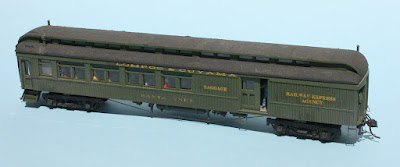Recently I had an on-line conversation with a modeling friend, and the age-old topic of layout modeling vs. contest modeling came up. We pretty much agreed on this topic, both of us understanding that contest modeling is quite a distinct activity of its own. I used as my illustrative example a model I built some years ago, specifically for NMRA regional and national contests when I lived in Pittsburgh, thus in Mid-Central Region (MCR).
The model I decided to build was a kit passenger car with enough added detail that it could compete for a Merit Award, and indeed it succeeded, at a time when model contests were quite competitive in MCR (and likely still are). Below is an overall view of the car. The removable roof is covered with strips of Kleenex soaked in paint to represent canvas. On this one side, I modeled the baggage door partly open, with a baggageman at the door.
At the time, my layout had been designed to represent a fictitious short line, the Lompoc & Cuyama, extending inland from the Pacific shore near Lompoc, up the Santa Rita Valley, then overland to Cuyama on the Santa Maria River. One town along the imagined route was the actual town of Santa Ynez, and I named the car “Santa Ynez” accordingly.
The kit for this model was a La Belle HO scale wood combine, and I assembled the body according to kit directions. This involved about 100 wood parts which had to be fitted and glued into a car body. But I discarded almost all the kit detail parts, thinking I could do better. All handrails and grab irons were fabricated with brass wire of various sizes, as was piping on the underbody.
The underbody was a point of emphasis, because it’s often neglected on model passenger cars. I consulted drawings in the 1925 and 1931 Car Builders’ Cyclopedia to develop the information I needed, and once it was modeled, I drew the various systems on the LaBelle kit drawing of the underframe to illustrate what I’d done, for the benefit of contest judges. It shows the air brake system, the Pintsch gas lighting components, and the pressurized water system. Pipe sizes are shown for each system.
The model underbody following the drawing above is shown below. The passenger brake gear is Cal-Scale; essentially everything else (except trucks and couplers and queenposts) is scratch-built. You can click on the image to enlarge it if you wish.
In addition to this underframe work, my goal was to add a fairly complete and detailed interior. This meant a full set of seats and a moderate number of passengers, along with details in the baggage compartment. In the passenger compartment, I added baseboard heater covers, a complete toilet including paper dispenser, luggage shelves at one end instead of overhead racks, and seats with commercial figures.
The baggage compartment has a water pump on a pallet, a bicycle, crates, boxes, sacks and parcels, most with tags, plus suitcases and a trunk. A toilet, locker, and a desk with pigeonholes are provided for the baggageman, along with a calendar and fire extinguisher.
Some modelers might react to the interior detail shown above, and think, “Why do all this work that can’t be seen, except with the roof unrealistically off?” The answer, as any contest modeler knows, is to maximize points for construction, detailing, and scratchbuilding. It’s a contest model, that’s all.
This was a lot of fun to imagine, design and build, and it did well in several contests, enough to earn a Merit Award, later used as part of my qualification for the NMRA Achievement Award as Master Car Builder. But this kind of contest modeling is simply not compatible with the time needed to build and maintain and operate a layout.
I’ve often told the story of a time in a regional contest room, when a group of us regular entrants were chatting, and one person said, “I’m starting my layout,” and someone else said, “Guess we won’t be seeing you in the contest room any more.” Of course the new layout builder protested, but most of us knew the comment was right.
Tony Thompson





A good friend of mine just recently presented me with this very car that he had built for my pike, the Louisiana Central. While he did put seats in it, he left the roof removable in case I decided to detail the interior more fully, and add passengers one day. Yours came out quite well.
ReplyDeleteThanks, Jack. I remember it was fun to plan and build.
DeleteTony Thompson